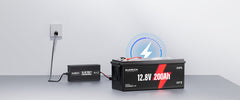
Can You Overcharge a Lithium Battery? The Surprising Truth.
, 5 Tiempo mínimo de lectura


, 5 Tiempo mínimo de lectura
Lithium batteries—especially LiFePO₄ (Lithium Iron Phosphate)—have become the go-to choice for modern energy storage. They power EVs, RVs, off-grid solar systems, e-bikes, boats, and home backup units thanks to high energy density, long cycle life, lightweight design, and reliable performance.
However, one concern keeps arising: Can a lithium battery be overcharged? And if it is, what actually happens? Let’s break it down.
Overcharging occurs when a battery continues receiving current after reaching its maximum safe voltage. Beyond this point, the chemistry is stressed, potentially causing permanent damage or safety hazards.
Comparison Table
|
Battery Type |
Tolerance |
Common Outcome |
Key Reason |
|
Lead-Acid |
Moderate |
Water loss, corrosion, shorter lifespan |
Excess energy vents as heat & gas |
|
Lithium-ion / LiFePO₄ |
Very Low |
Internal damage, swelling, thermal runaway |
Chemical stress at high voltage |
Tip: A 12 V LiFePO₄ battery is typically full at ~14.6 V (~3.65 V per cell). Always follow the manufacturer’s datasheet.
3.1. Reduced Lifespan
Overcharging accelerates capacity fade and shortens usable cycles.
Example: In a solar storage system, overcharge reduces evening runtime.
3.2. Safety Hazards
Excess voltage can cause overheating and internal pressure; in extreme cases, thermal runaway may occur.
Example: An overcharged e-bike pack may swell, fail, or ignite.Safety Note: Never intentionally overcharge. Risks are higher with damaged or unprotected batteries.
3.3. Cumulative Damage
Repeated mild overcharges degrade performance over time.
Example: An RV battery consistently overcharged may lose runtime after one season.
Modern systems use multiple layers of protection so overcharging is rare when installed correctly.
4.1 Battery Management System (BMS)
A good BMS monitors cell voltage, current, and temperature, and cuts off charging at the safe limit. Many also include cell balancing and high/low temperature protection.
▪ Sunrich LiFePO₄ batteries include a smart BMS that enforces safe voltage cut-offs and thermal safeguards to prevent overcharge damage.
4.2 Smart Chargers (CC/CV)
Lithium batteries require Constant-Current / Constant-Voltage charging and automatic termination at full charge.
▪ Pairing Sunrich batteries with the recommended smart charger ensures correct CC/CV behavior and prevents “force-charging” a full pack.
4.3 Chemistry Advantage (LiFePO₄)
Not all lithium chemistries behave the same. LiFePO₄ is renowned for thermal stability and safety, making it a great fit for RVs, boats, cabins, and home storage—which is why Sunrich builds its packs on LiFePO₄ chemistry.
Quick diagnostic cues: Excess warmth at full charge, repeated BMS cutoffs, swelling, or a charger that refuses to terminate—inspect immediately if observed.
|
Myth |
Reality / Best Practice |
|
Leaving the charger plugged in always overcharges |
Modern BMS and smart chargers stop charging. Avoid indefinite connection to minimize stress. |
|
Any charger works with lithium batteries |
Using the wrong charger risks overvoltage and damage. Always match charger to battery chemistry & voltage. |
Safe Charging Tips:
✔Use a charger designed for your battery chemistry & voltage.
✔Avoid charging in extreme heat (>113°F / 45°C) or freezing conditions.
✔Inspect for swelling, cracks, or unusual heat.
✔Store long-term at ~50% charge; top up every few months.
|
Focus |
Recommendation |
|
Battery |
Use lithium batteries with a built-in BMS |
|
Charger |
Use dedicated CC/CV smart chargers |
|
Charging |
Avoid unnecessary long-term plug-in |
|
Maintenance |
Inspect battery appearance & performance |
|
Monitoring |
Use meters/apps to track voltage & temperature |
Yes, lithium batteries can be overcharged if protections fail or the wrong charger is used. Overcharging can shorten the lifespan and create safety hazards.
Key Takeaways:
▪ Use a charger matched to your battery’s chemistry & voltage.
▪ Trust the BMS to prevent overcharge.
▪ Avoid unnecessary long-term charging or extreme temperatures.
By following these practices, you can enjoy safe, reliable, and long-lasting power for your RV, solar system, e-bike, or home backup—without worrying about overcharging.